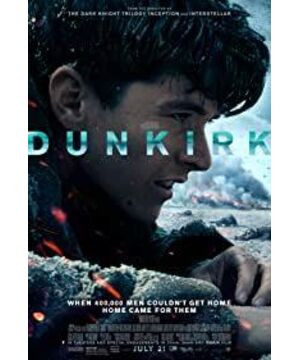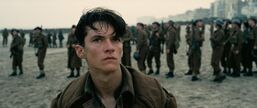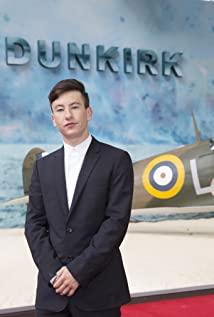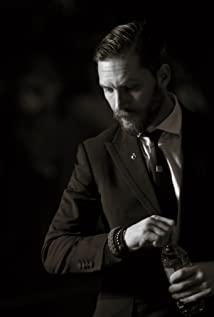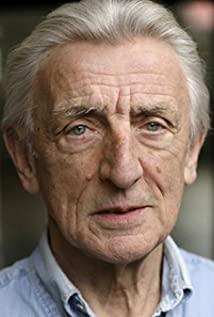Probably because I was watching a normal field, I didn't have a deep impression of the music. Even I completely forgot about the music when I watched it. I was completely attracted by the plot. If you don’t understand the timelines of three different scales: 1. Wharf (one week); 2. Sea (one day); 3. Sky (one hour), it is difficult to understand what is going on here during the day and the other at night. . It’s even more difficult if you’re face-blind like me. I don’t know who is who is. If I didn’t do my homework beforehand, I couldn’t follow it at all. At the end I still missed a plot. I’ll come back to see the sea fish. The film review was added.
There will be serious spoilers next, so enter with caution.
The three timelines of different scales are really amazing. The largest time span is the pier line, which is said to be a week, but in fact, the film performance is about a day and a half. From the day before, the British boy was chased by the enemy while patrolling the street, fled to the beach and tried to line up. When the ship returned to England, they encountered a French brother who was changing clothes. The two had an idea. They pretended to be health workers carrying wounded and sick soldiers. However, the ship was blown up before it left. The two men again pretended to be those who dived from the boat to survive, and were sent to another boat in the evening along with another British soldier who had fallen into the water they had rescued. This ship was a navy destroyer, with jam, bread and tea on it. The French brother was afraid of being recognized as an Englishman, so he secretly hid outside. It was this care that saved his life. Soon there was a torpedo launched by a German submarine, which sank the destroyer. Almost all the people in the cabin were drowned. Fortunately, the French brother had a conscience. He went to open the cabin door, and the British brother who accompanied him. Escaped. The three of them returned to the shore together with the lifeboat. The next day, at dawn, the three found that a group of soldiers was sneaking towards a stranded fishing boat, so they went with them to see if they had a chance to escape together. The ship was in an enemy-occupied area, so it was extremely dangerous. It had to wait for the high tide to leave. After a crisis, the ship finally floated, but because it was missed by the Germans before, it hadn’t traveled far. It sank. The French brother finally did not escape and was drowned in the boat, while the other two British brothers escaped. They were hitting the destroyer carrying troops and sunk by a German plane. They came to rescue. The boat was rescued. This boat was Mr. Dawson’s Moonstone. They returned to England on the Moonstone. It was midnight and they immediately got on the train. They woke up in the mainland the next day. One of the British brothers was very guilty and felt that he was a deserter, but he read Churchill’s story in the newspaper. During the speech, they transferred a total of 330,000 people.
The second timeline is "Sea-One Day". Starting from the British port, the Navy requisitioned Mr. Dawson’s small yacht Moonstone. Mr. Dawson set off with his son, and George, who was helped by the neighbor’s family, also joined voluntarily. . They saw many small boats that voluntarily joined the soldiers at sea. On the way, they rescued a surviving soldier who had floated on the sunken ship. When he learned that they were sailing to Dunkirk, he suddenly went crazy and demanded They turned the ship's bow and went back. It turned out that his ship was sunk by a torpedo from a German submarine. Mr. Dawson refused, and after some dealings, the soldiers fumbled and pushed George down the stairs. George was seriously injured and the soldiers no longer resisted. They encountered the British Air Force twice during the voyage. The second time they saw the Collins plane crash-landing due to an injury, they hurried over to save people and finally rescued Collins. The group continued on to Dunkirk, and they were about to reach the beach. They encountered a destroyer and were sunk. They rescued a few soldiers who fell into the water. The sea was full of fuel, which was very dangerous. At this time, the German bomber was destroyed and crashed, igniting the oil slick on the sea, and they hurried to leave. At this time, Mr. Dawson's son discovered that George was dead. In memory of George, after he returned to England, he wrote an article in the local newspaper to commemorate him, saying that he died to rescue Dunkirk.
The third timeline is "Sky-One Hour", which is the air battle between pilots Farrier and Collins. At the beginning they had 70 gallons of oil from London. The first air battle ended with only 50 gallons of oil, and the second air battle ended with only 15 gallons. Collins was shot and forced to land and was rescued by Mr. Dawson's son. At this time, he also reminded Farrier that the fuel is not enough, don’t fly anymore, but looking at the black smoke of Dunkirk in the distance, Farrier got entangled for a moment or continued to fly forward, just when he encountered the German bombing destroyer, he was entangled. Later, he pulled the accelerator, climbed up for a while and shot down the bomber, and then there was no fuel. Seeing that the propellers stopped, he saw an escorted fighter plane. He used superb technology to use the fuel from the spare fuel tank. I killed the enemy plane, so I finally ran out of fuel. I glide to the beach controlled by the enemy and make an emergency landing. I burned the plane and was captured by the Germans who had driven over.
I struck out all three lines, but in fact, the three lines in the movie have been running in parallel since the beginning, and they have nothing to do with each other. ), I am really a bit confused. But there is a faint connection between the three lines. The neurotic soldier rescued by Mr. Dawson in the second line was later found to have appeared in the first line. The British brother’s boat was sunk by a torpedo and escaped and wanted to board a lifeboat, but the officer on the lifeboat At that time, he refused to let them on the boat. The British brother replied that he would know when you were torpedoed. This officer was the soldier who was later rescued by Dawson. At this point, the time difference between the first and second lines can be seen. And Dawson saved Collins, and the time difference between the second and third lines was aligned. Until the scene on the beach, the three lines finally synchronized in the same time and space, so there was a situation where the same thing was played three times from different angles. The first time is the sky, the second time is the sea, and the third time is the dock. Moreover, several angles are switched in this short period of time, which is really too brain-intensive, because each line does not take a long time. So it feels very fast, not dull at all.
The three timelines are not the three narrative lines in the general sense, because their temporality is different. It's like the long period, medium period and short period of the French Almanac School. How to combine the three temporalities in the narrative, which is complicated and not chaotic, and echoes and intersects each other, is really interesting and challenging. I feel very excited to think that text can also be processed in this way, and I really want to write a book in this way. The role of this technique in historical writing is obvious. Although historians have a deep understanding of different temporalities, few people try to deal with different temporalities in one text, even if they are to be written. Put the background first, then talk about the event, and finally analyze the structure. The closest thing to this approach, I can think of Kong Feili's "Calling the Soul". As far as the real world is concerned, we all live in the interlacing of different temporalities. The same thing, in different timeliness, will have different appearances, embedded in different causal relationships. The so-called angle is actually a kind of timeliness. We are too accustomed to timepieces in the objective Newtonian sense, and we have lost the understanding and expression of the subjective sense of time and the timeliness of construction. The latter is very important for both history and literature.
What's interesting is that I just went to review the real history of Dunkirk, and the one day shown in Nolan's movies is impossible. At the beginning of the movie, the admiral still complained about Churchill's request to evacuate 30,000 people, but there were 400,000 people on the beach. At that time, just look at those people on the beach, and only five or six thousand people died. When the British brother returned to the UK two days later, Churchill’s speech had been published in the newspapers. The retreat was over, and a total of 330,000 people were evacuated. In real history, it took almost 11 days for these 330,000 people to withdraw. Nolan completely disrupted the timeline, so the truth is not what happened in Dunkirk in Newtonian time, but what happened to each participant. This is the subjective sense of time I mentioned earlier. . It is said that the plot inside has its roots, such as Grandpa Dawson commanding the ship to avoid fighter jets, but these characters are all fictitious. The truth is not about recreating what happened like a camera, but about reconstructing it on a higher level. Since it is no longer possible to go back to the past, since the movie is originally fiction, let's make the fiction more realistic. This is also very interesting.
I am ignorant and feel like being opened a window by Teacher Nolan. Next, there are many things to do.
Those who don’t know can go to the script again: http://www.scripts.com/script.php?id=dunkirk_1195&p=1
View more about Dunkirk reviews


